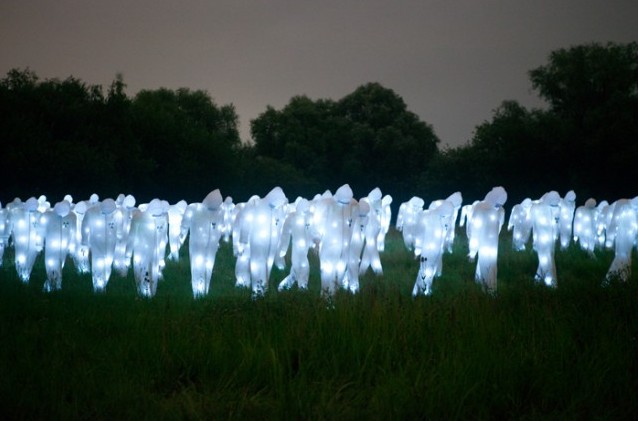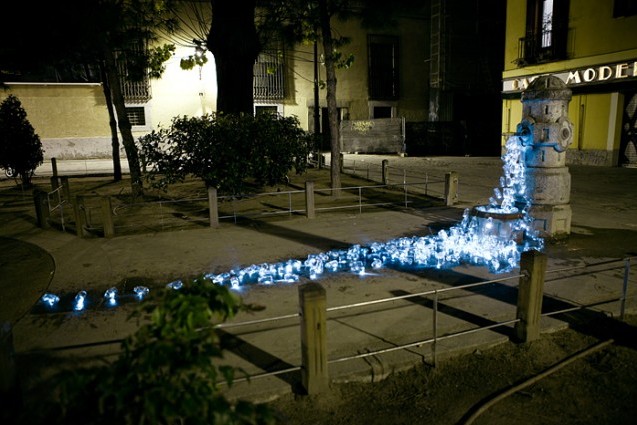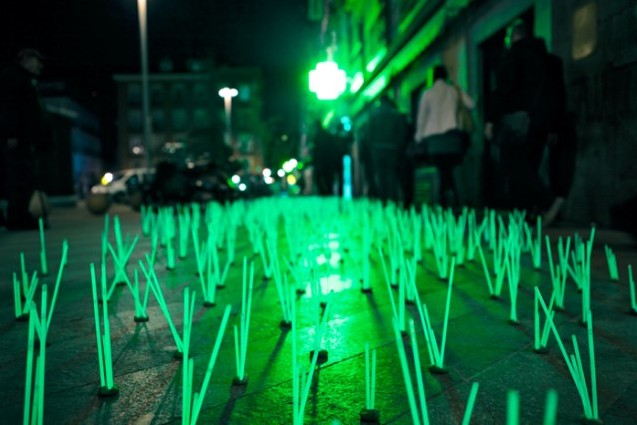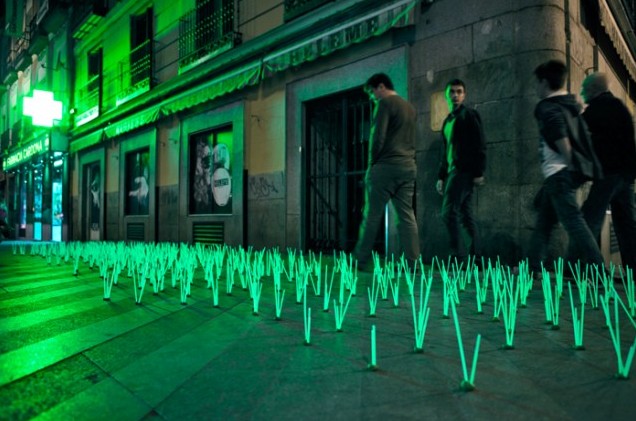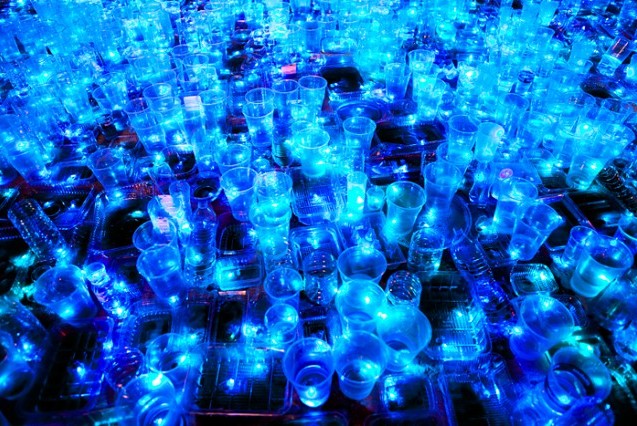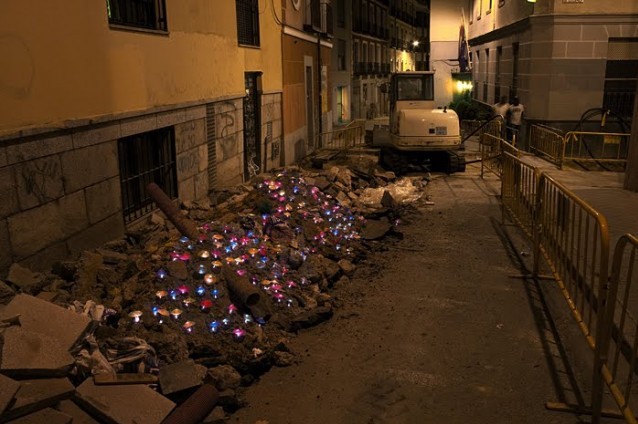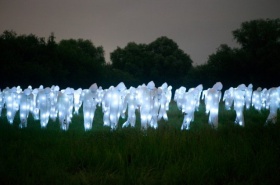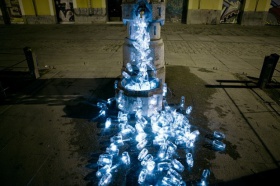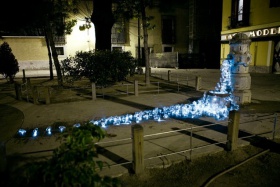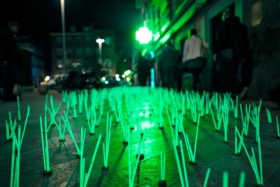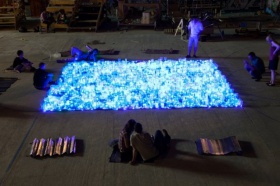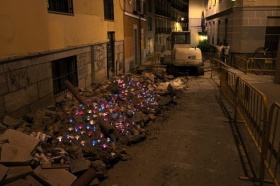Difference between revisions of "project01:CASE STUDIES"
Gary Chang (Talk | contribs) (Created page with "__NOTOC__ __NOTITLE__ 850px <div style="height:30px; width: 850px; margin:0px; padding: 0px; padding-top: 20px; border: 0px;"> <div style="float:left; wi...") |
(→CASE STUDIES:) |
||
| Line 23: | Line 23: | ||
== '''CASE STUDIES: ''' == | == '''CASE STUDIES: ''' == | ||
| + | |||
| + | 1. Performative Ecologies | ||
| + | |||
| + | <html> | ||
| + | <iframe src="//player.vimeo.com/video/3337399" width="850" height="480" frameborder="0" webkitallowfullscreen mozallowfullscreen allowfullscreen></iframe> <p><a href="http://vimeo.com/3337399">Performative Ecologies, Ruairi Glynn</a> from <a href="http://vimeo.com/user1321824">Ruairi Glynn</a> on <a href="https://vimeo.com">Vimeo</a>.</p> | ||
| + | </html> | ||
| + | |||
| + | ‘Performative Ecologies’ creates an interaction between a series of dancing robots and visitors. Rather than being pre-choreographed, these robots are able to learn how best to attract and maintain visitors’ attention by reading the visitors’ gestures. As the robots gain experience, they can also share their knowledge with each other, dancing to each other and negotiating future performances collaboratively. | ||
| + | Reflection: The key part of this interaction is the learning process of these robots, which is achieved by a genetic algorithm. Designers tried to add a kind of artificial intelligence to the dancing robots. But from our perspective, this is still not a true intelligence because the performance of the robots is inevitably constrained by the inner coding which is already choreographed. As a result, visitors could probably foresee the reaction of robots after playing with them several times. | ||
| + | |||
| + | |||
| + | |||
| + | 2. Constellaction and Light Interventions | ||
| + | |||
| + | <html> | ||
| + | <iframe src="//player.vimeo.com/video/76479685" width="850" height="480" frameborder="0" webkitallowfullscreen mozallowfullscreen allowfullscreen></iframe> <p><a href="http://vimeo.com/76479685">CONSTELLACTION</a> from <a href="http://vimeo.com/pangenerator">◥ panGenerator</a> on <a href="https://vimeo.com">Vimeo</a>.</p> | ||
| + | </html> | ||
| + | |||
| + | |||
| + | {{#slideshow: | ||
| + | <div>[[File:Light Interventions1.jpg| 850px]]</div> | ||
| + | <div>[[File:Light Interventions2.jpg| 850px]]</div> | ||
| + | <div>[[File:Light Interventions3.jpg| 850px]]</div> | ||
| + | <div>[[File:Light Interventions4.jpg| 850px]]</div> | ||
| + | <div>[[File:Light Interventions5.jpg| 850px]]</div> | ||
| + | <div>[[File:Light Interventions6.jpg| 850px]]</div> | ||
| + | <div>[[File:Light Interventions7.jpg| 850px]]</div> | ||
| + | <div>[[File:Light Interventions8.jpg| 850px]]</div> | ||
| + | <div>[[File:Light Interventions9.jpg| 850px]]</div> | ||
| + | |id=bar2 sequence=forward transition=fade refresh=2000 | ||
| + | }} | ||
| + | |||
| + | [[File:Light Interventions1.jpg|280px]][[File:Light Interventions2.jpg|280px]][[File:Light Interventions3.jpg|280px]] | ||
| + | [[File:Light Interventions4.jpg|280px]][[File:Light Interventions5.jpg|280px]][[File:Light Interventions6.jpg|280px]] | ||
| + | [[File:Light Interventions7.jpg|280px]][[File:Light Interventions8.jpg|280px]][[File:Light Interventions9.jpg|280px]] | ||
| + | |||
| + | http://www.arch2o.com/light-interventions-luzinterruptus/#prettyPhoto | ||
| + | |||
| + | Both ‘Constellaction’ and ‘Light Interventions’ are constituted by groups of very simple units with light. In the former project, people are allowed to compose these pyramid-units in any way they want and create complicated and strong results. In the latter project, these units are placed ‘randomly’ in anonymous or unnoticed places in city to highlight these places. It is a kind of reminder and redevelopment of these unnoticed spaces without building a true thing there. | ||
| + | Reflection: In our opinion, this kind of ‘bottom-up’ design provides more space to people to interact with the products. In the process of interaction, players are designers at the same time. But in these two projects, the variety of performance of these units seems too less. | ||
Revision as of 17:30, 3 April 2014
CASE STUDIES:
1. Performative Ecologies
Performative Ecologies, Ruairi Glynn from Ruairi Glynn on Vimeo.
‘Performative Ecologies’ creates an interaction between a series of dancing robots and visitors. Rather than being pre-choreographed, these robots are able to learn how best to attract and maintain visitors’ attention by reading the visitors’ gestures. As the robots gain experience, they can also share their knowledge with each other, dancing to each other and negotiating future performances collaboratively. Reflection: The key part of this interaction is the learning process of these robots, which is achieved by a genetic algorithm. Designers tried to add a kind of artificial intelligence to the dancing robots. But from our perspective, this is still not a true intelligence because the performance of the robots is inevitably constrained by the inner coding which is already choreographed. As a result, visitors could probably foresee the reaction of robots after playing with them several times.
2. Constellaction and Light Interventions
CONSTELLACTION from ◥ panGenerator on Vimeo.
http://www.arch2o.com/light-interventions-luzinterruptus/#prettyPhoto
Both ‘Constellaction’ and ‘Light Interventions’ are constituted by groups of very simple units with light. In the former project, people are allowed to compose these pyramid-units in any way they want and create complicated and strong results. In the latter project, these units are placed ‘randomly’ in anonymous or unnoticed places in city to highlight these places. It is a kind of reminder and redevelopment of these unnoticed spaces without building a true thing there. Reflection: In our opinion, this kind of ‘bottom-up’ design provides more space to people to interact with the products. In the process of interaction, players are designers at the same time. But in these two projects, the variety of performance of these units seems too less.

